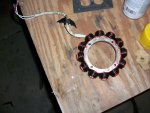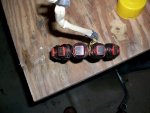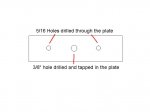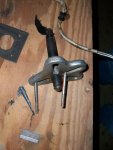I removed the Voltage Regulator from the 2700 hr unit and put it on the 50 hour "no charge" machine and still got 7 or 8 volts with the red banded white wire removed. Remove the neg. batt post while the machine is running and it dies. Even though my stator tested good numerous times by the book I wonder if it's the problem?
David
I see that in an earlier post you did re-test the stator output, and had about 33 volts (33.2 to be exact). The stator is good.
I am a bit confused as to why you keep stating all of these meter readings you get at the fuse holder and at the red marked wire on the VR as being ac volts. All of those places you should be reading
DC volts. The only place you should see any ac voltage readings will be on the two wires coming from the stator. The readings you are getting on the DC side with your meter set on ac are probably just transient readings and do us no good to help you troubleshoot the problem.
When you said your machine is shutting down, was that with the known good VR from the 2700 hour machine on it? If it was then I think you have a bad wire somewhere. The batteries should not effect the machine running at all. When you remove the negative, obviously the fuel pumps are stopping and probably the fuel cut out solenoid may be dropping out because they no longer have a complete path for the 24 volts they need because they are running off of the batteries and not the charging system like they should be..
This tells me that the positive and ground paths are good to the batteries, but the 24 volt path between the DC VR and the batteries is no good. The VR should ground to the frame, so unless it's got an extremely bad ground it should be ok, but check it anyway. I would start by hooking everything up properly, and leave the machine off (not running). Have a good fuse in the fuse holder, and check for
24 volts DC at the red marked wire of the DC VR to the VR ground. Even though the set is not running, electrically that wire is still directly connected to the batteries and you should read 24 volts from the batteries. From what you are saying I'm wiling to bet you don't get 24 volts at that wire, I could be wrong though.
If you don't get 24 volts then you need to follow that wire the whole way to the batteries ( or where ever it goes, I'm not sure of the exact path of that wire) and find where you are loosing the voltage. Start with the fuse holder (both sides) checking to ground and at every junction or splice in that wire until you start getting 24 volts...once you find the 24 volts then you'll know where you are loosing it at (between the point where you find it and the next point toward the VR where you didn't have it). Fix that problem and I'll bet you get your charging system back.







